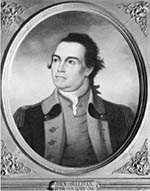In the midst of the Revolutionary War, the American army conducted a war of conquest against the Six Nations of the Iroquois.

During the American War of Independence from Great Britain, both sides formed alliances with various of the Indian nations. These alliances pitted tribe against tribe in what amounted to a civil war. Nowhere was this struggle more devastating than among the Iroquois Confederacy, also called the Six Nations, inhabiting what is now upstate New York. In the summer of 1779, the Iroquois lands were subjected to a war of destruction by a large American force under the command of Major General John Sullivan.
The Iroquois Threat to New York
Four of the Six Nations sided with the British – The Seneca, Cayuga, Mohawk, and many of the Onondaga – while the Oneida and the Tuscarora fought with the Americans. By the end of 1778, while the British regular army was confining the Continental forces to the eastern seaboard, their Indian allies conducted constant raids on the American settlements in their territory. General George Washington, feeling the necessity of taking some action in upper New York, and wanting to encourage support among New Englanders for the war effort, called on Major General John Sullivan of New Hampshire, along with Major General James Clinton of New York, to lead a force against the enemy Iroquois.
The Order for a Scorched-Earth Campaign
In the spring of 1779, around 4,500 soldiers were assembled under General Sullivan to engage the Iroquois. Their orders, from Washington himself, were to “lay waste all the settlements around … that the country may not be merely overrun but destroyed.” Sullivan’s men did just that. By their own count, they burned virtually all the Iroquois villages, destroyed 160,000 bushels of corn, and girdled thousands of fruit trees. Relatively few Indians were captured or killed. But their homes and supplies and food sources were wiped out. One historian called Sullivan’s expedition “the most ruthless application of a scorched-earth policy in American history” – rivaled only by Sherman’s march through Georgia and the American search-and-destroy missions in Vietnam.
The Aftermath of Sullivan’s War on the Iroquois
In the wake of the Sullivan expedition, thousands of Iroquois took refuge in southern Canada, where they remained through the “hard winter” of 1779-1780 – one of the coldest and snowiest on record. In the spring, however, they poured south into New York, bent on revenge. As a contemporary put it, “The nests are destroyed, but the birds are still on the wing.” For the next two years, both sides continued their scorched-earth campaigns, until finally there was little or nothing left to destroy.
When the Revolutionary War was over and the Americans had won their independence, the defeated British sailed back to their homeland. The Indians, whether allied with the British or the Americans, had also been defeated – and they had no place to go back to. The victorious Americans regarded all Indian lands as their own; indeed, possession of those lands had been one of the main objectives in throwing off British rule. Within fifty years, the native nations that had lived for centuries east of the Mississippi had been either removed or exterminated.
Source:
- Nash, Gary B. The Unknown American Revolution: The Unruly Birth of Democracy and the Struggle to Create America. New York: Viking Penguin, 2005.








